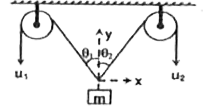Parallelogram law of addition of vectors
Video Solution
|
Answer
Step by step video & image solution for Parallelogram law of addition of vectors by Maths experts to help you in doubts & scoring excellent marks in Class 12 exams.
Updated on:21/07/2023Similar Questions
Knowledge Check
Assertion: A vector qunatity is a quantity that has both magnitude and a direction and obeys the triangle law of addition or equivalentyly the parallelogram law of addition.
Reason: The magnitude of the resultant vector of two given vectors can never be less than the magnitude of any of the given vector.AResistanceBChargeCVoltageDCurrentAssertion : A vector quantity is a quantity that has both magnitude and a direction and obeys the triangle law of addition and equivalently the parallelogram law of addition.
Reason : The magnitude of the resultant vector of two given vectors can never be less than the magnitude of any of the given vector.AResistanceBChargeCVoltageDCurrentSTATEMENT-1: In the figure shown, the y-component of velocity of m is (u1cosθ1+u2cosθ2) when the string is being pulled with speed u1andu2 as shown in the figure.

STATEMENT-2: According to parallelogram law of vector addition the sum of two independent vectors is given by the diagonal of the parallelogram if the two vectors are represented by the adjacent sides of the parallelogram.AStatement-1 is True, Statement-2 is True, Statement-2 is a correct explanation for statement-1.BStatement-1 is True, Statement-2 is True, Statement-2 is NOT a correct explanation for Statement-1.CStatement-1 is True, Statement-2 is False.DStatement-1 is False, Statement-2 is True.
Component Of Vector|Questions|Vector|Questions|Parallelogram Law Of Addtion Of Two Vectors|OMR
View SolutionProperties of addition of vectors
View SolutionParallelogram Law of Vector Addition
View Solution2.Addition Of Vector
View SolutionState parallelogram law of vectors addition .Find analytcallly the magnitude and direction of resultant vector, When (i) two vectors are parallel to each other (ii) two vectors are perpendicular to each other.
View Solution
